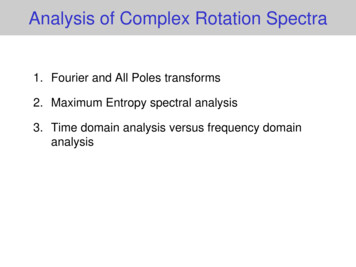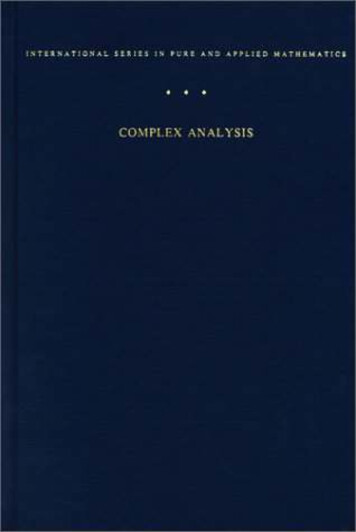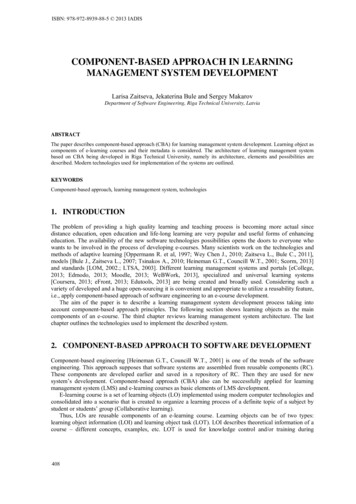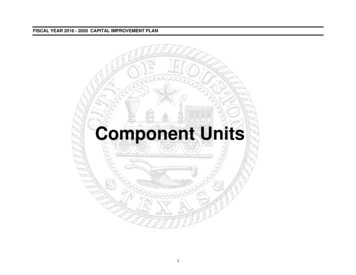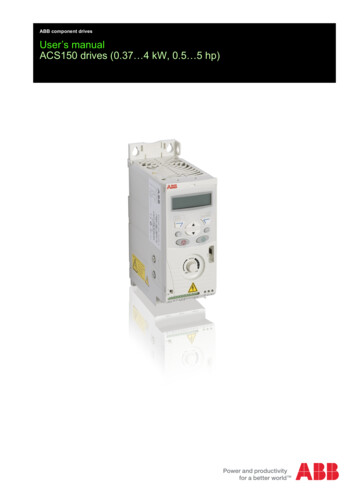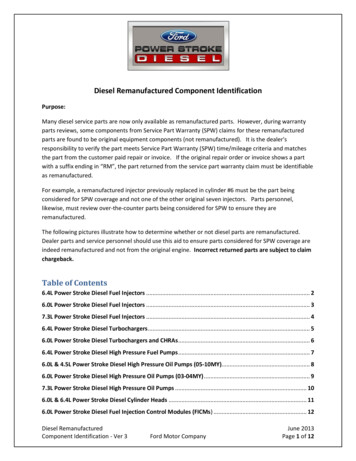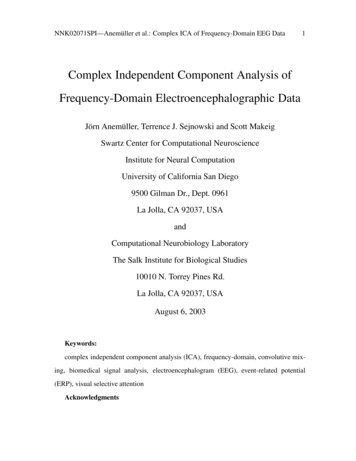
Transcription
NNK02071SPI—Anemüller et al.: Complex ICA of Frequency-Domain EEG Data1Complex Independent Component Analysis ofFrequency-Domain Electroencephalographic DataJörn Anemüller, Terrence J. Sejnowski and Scott MakeigSwartz Center for Computational NeuroscienceInstitute for Neural ComputationUniversity of California San Diego9500 Gilman Dr., Dept. 0961La Jolla, CA 92037, USAandComputational Neurobiology LaboratoryThe Salk Institute for Biological Studies10010 N. Torrey Pines Rd.La Jolla, CA 92037, USAAugust 6, 2003Keywords:complex independent component analysis (ICA), frequency-domain, convolutive mixing, biomedical signal analysis, electroencephalogram (EEG), event-related potential(ERP), visual selective attentionAcknowledgments
NNK02071SPI—Anemüller et al.: Complex ICA of Frequency-Domain EEG Data2J. A. was supported by the German Academic Exchange Service (DAAD) and the German Research Council (DFG). We acknowledge support from the Swartz Foundation.Corresponding author J. A., Tel. 1-858-458-1927x18, Fax. 1-858-458-1847, Email address: jorn@salk.edu
NNK02071SPI—Anemüller et al.: Complex ICA of Frequency-Domain EEG DataAbstractIndependent component analysis (ICA) has proven useful for modeling brain and electroencephalographic (EEG) data. Here, we present a new, generalized method to better capture the dynamics of brain signals than previous ICA algorithms. We regardEEG sources as eliciting spatio-temporal activity patterns, corresponding to, e.g., trajectories of activation propagating across cortex. This leads to a model of convolutivesignal superposition, in contrast with the commonly used instantaneous mixing model.In the frequency-domain, convolutive mixing is equivalent to multiplicative mixing ofcomplex signal sources within distinct spectral bands. We decompose the recordedspectral-domain signals into independent components by a complex infomax ICA algorithm. First results from a visual attention EEG experiment exhibit (1) sources ofspatio-temporal dynamics in the data, (2) links to subject behavior, (3) sources with alimited spectral extent, and (4) a higher degree of independence compared to sourcesderived by standard ICA.3
NNK02071SPI—Anemüller et al.: Complex ICA of Frequency-Domain EEG Data41 IntroductionIndependent component analysis (ICA) is effective in analyzing brain signals and in particular electroencephalographic (EEG) data (e.g., [Makeig et al., 1996, Makeig et al., 2002]),and ICA continues to be useful for building new models of experimental data. However,ICA algorithms presently applied to brain data rely on several idealized assumptions aboutthe underlying processes that may not be fully applicable. Although the results so far obtained with ICA are significant and justify its continued use, it is nevertheless desirable toadvance the ICA methodology by allowing more realistic modeling of EEG dynamics.One principal limitation imposed on ICA algorithms is the mixing process by whichthe source signals are assumed to be superimposed to form the measured sensor signals.Presently, ICA analysis of brain data is carried out assuming a linear and instantaneousmixing process that can be expressed mathematically as multiplication by a single mixingmatrix. The physics of electromagnetic wave propagation support instantaneous summation at the electrode sensors since capacitive effects within the head are generally regardedas negligible at EEG frequencies of interest [Lagerlund, 1999].The standard ICA model the component signal sources are thought of as neural activity occurring in a perfectly synchronized manner within spatially fixed cortical domains.This assumption might be too strong, as it does not take into account the possible spatiotemporal dynamics of the underlying neural processes, e.g., propagation of neuronal activity, traveling wave patterns of activity, or synchronization between different brain areaswith a non-zero phase lag [Freeman, 1975, Lopez da Silva and Storm van Leeuwen, 1978,Arieli et al., 1996, Stein et al., 2000]). One way to allow the effective sources to exhibitmore complex dynamics is to assume a convolutive mixing model. In a convolutive mixingprocess, a single impulse-like activation of an EEG component may elicit a sequence of potential maps with varying spatial topography; such a model may thereby allow for patternsof spatial propagation of EEG activity. Separation of convolutively mixed sources into
NNK02071SPI—Anemüller et al.: Complex ICA of Frequency-Domain EEG Data5independent EEG components is not feasible under the instantaneous mixing assumption,since the temporal autocorrelation of the EEG results in statistical dependencies betweenthe time-courses of consecutive potential maps. At best, instantaneous ICA may separatemoving sources into separate stationary components with overlapping ‘frames’ of activation [Makeig et al., 2000].A fundamentally different phenomenon, also neglected by the standard ICA model, isthe spectral quality of EEG signals. EEG researchers have long been familiar with the factthat EEG activity has distinctive characteristics in different frequency bands (conventionally delta, theta, alpha, beta, and gamma) which may be associated with different physiological processes ([Berger, 1929], and also [Makeig and Inlow, 1993]). It may therefore bemore appropriate to allow for the existence of different functionally independent sourcesin different frequency bands by modeling the source superposition with a different mixingmatrix for each frequency band.To overcome both shortcomings, we approach convolutive independent componentanalysis of EEG signals through complex ICA applied to different spectral bands. Convolutive mixing in the time-domain is equivalent to multiplicative mixing in the frequencydomain with generally distinct complex-valued mixing coefficients in different frequencybands. Therefore, by moving to the frequency-domain, both spatio-temporal source dynamics and frequency-specific source processes may be modeled. Solutions obtained under thestandard ICA model with instantaneous mixing in the time-domain form a subset within thesolution space of complex frequency-domain ICA, corresponding to signal superpositionwith the same real-valued mixing matrix in all frequency bands.The method consists of two processing stages (cf. Fig. 1). First, the measured EEGsignals are decomposed into different spectral bands by short-time Fourier transformationor wavelet transformation, yielding a complex-valued spectro-temporal representation foreach electrode signal. Then, a separate independent component analysis is performed on
NNK02071SPI—Anemüller et al.: Complex ICA of Frequency-Domain EEG Data6the complex frequency-domain data within each spectral band, producing, for each band, aset of complex independent component activation time-courses and corresponding complexscalp maps. We also investigate the case of a constrained complex ICA algorithm wherethe independent component (IC) activations remain complex, but the IC scalp maps arerequired to be real-valued.[Figure 1 about here.]Within each spectral band, the proposed algorithms find a number of maximallyindependent components equal to the number of employed data channels.Hence,across frequencies the method has the potential of identifying more independent processes than the number of electrodes. But since EEG processes may not be narrowband, but may exhibit dynamics within multiple contiguous or disconnected bands, independent components at different frequencies might also originate from the same spatial EEG generator sources.This could, e.g., be the case for mu-rhythm activity[Niedermeyer and Lopes da Silva, 1999] which is characterized by concurrent activity near10 Hz and 20 Hz. We present methods for evaluating the similarity of independent components at different frequencies and for grouping together those components arising fromsingle physiological processes.Convolutive mixing models have been used for blind source separation in other domains. For example, in the case of speech signals the physics of wave propagation in airdirectly leads to a convolutive mixing process (e.g., [Anemüller, 2001]). However, speechsignals are generally modeled as wide-band sources, emitting energy essentially over theentire spectral range of interest. The same assumption cannot be made for brain signals, sothat corresponding convolutive ICA algorithms cannot be applied directly to the problem athand. On the other hand, narrow-band sources are also encountered in telecommunicationsapplications, leading to ICA algorithms similar to the one presented here [Torkkola, 1998].However, a strict narrow-band assumption may not be completely justified for brain signal
NNK02071SPI—Anemüller et al.: Complex ICA of Frequency-Domain EEG Data7sources, as mentioned above. The methods presented in this paper appear to be sufficientlyflexible to model signals in all the aforementioned scenarios.The remainder of the paper is organized as follows: In sections 2.1 and 2.2, we definethe spectral decomposition and mixing model. We derive a complex variant of the infomaxICA algorithm [Bell and Sejnowski, 1995] in section 2.3 from the maximum-likelihoodprinciple, and discuss a variant constrained to real scalp maps in section 2.3.1. Visualization of complex activations and maps is discussed in 2.3.2. Section 2.3.3 defines second and fourth order measures for assessing the quality of the separation. In section 2.4we present methods for measuring similarities between independent component in distinctspectral bands. Section 2.5 presents methods for comparing real time-domain and complex frequency-domain ICA results. Finally, we apply these methods to data from a visualattention task EEG experiment in section 3.2 Methods2.1 Spectral decompositionConsider measured signals xi t , where i 1 M denotes electrodes. Their spectraltime-frequency representations are computed asxi T f xi T ττ b f τ (1)where f denotes center frequency, and b f τ the basis function which extracts the spectralband f from the time-domain signal. The basis function is centered at time T . Hence,data of size channels itimes t is transformed into data of size channels itimes Tfrequencies f .In this paper, we consider the decomposition by means of the short-time Fourier trans-
NNK02071SPI—Anemüller et al.: Complex ICA of Frequency-Domain EEG Data8formation, such that b f τ is given byb f τ h τ e 2π f τ 2K(2) h τ being a windowing function (e.g., a hanning window) with finite support in the intervalτ K K 1, and 2K denoting the window length. Correspondingly, the frequencyindex acquires values f 0 K. Since the product of time- and frequency-resolutionis bounded from below by 0 5, the chosen windowing function and window length givelimited frequency-domain resolution. Hence, variability across frequencies is limited andresults should be interpreted accordingly.2.2 Mixing modelFor each frequency band f the signals x T f x1 T f xM T f T are assumed tobe generated from independent sources s T f s1 T f sN T f T by multiplicationwith a frequency-specific mixing matrix A f ,x T f A f s T f (3)with rank A f N. Noise is assumed to be negligible. We restrict the presentation tosquare-mixing, M N, though our methods are also applicable to the case MN. Theestimates u T f of the sources are obtained from the sensor signals by multiplication withfrequency-specific separating matrices W f ,u T f W f x T f (4)2.3 Complex ICATo derive the complex infomax ICA algorithm, we model the sources s i T f as complexrandom variables with a circular symmetric, non-Gaussian probability density function
NNK02071SPI—Anemüller et al.: Complex ICA of Frequency-Domain EEG Data9Ps s . Since the phase arg si T f depends only on the relative position of the windowcenters T with respect to the time-domain signal si t , the property of circular symmetry ofthe distribution Ps s is a direct result of the window-centers being chosen independentlyof the signal. Hence, Ps s depends only on the magnitude s of s and can be written asPs s g s with the function g ! :" #(5)being a real-valued function of its real argument. Our"investigation of the statistics of frequency-domain EEG in section 3.1 demonstrates thedata’s positive kurtosis. Therefore, we choose Ps s as a super-Gaussian distribution. Theassumed two-dimensional distribution Ps s over the complex plane is illustrated in Fig. 2.Its super-Gaussian nature is best seen by plotting the corresponding distribution P % s % s of the magnitude s versus the corresponding distribution (a Rayleigh distribution) for atwo-dimensional Gaussian distribution of the same variance, as illustrated in Fig. 3.[Figure 2 about here.][Figure 3 about here.]The separating matrix W f is obtained by maximizing the log-likelihood L W f ofthe measured signals x T f given W f , which in terms of the source distribution P s isL W f '& log Px x T f ( W f )where!& ) TT log det W f *& log Ps W f x T f )T (6)denotes expectation computed as the sample average over T . We perform max-imization by complex gradient ascent on the likelihood-surface. The i j -element δw i j f of the gradient matrix W f is defined as δwi j f ℜwi j f -, L W f ℑwi j f (.(7)
NNK02071SPI—Anemüller et al.: Complex ICA of Frequency-Domain EEG Data10where / ℜwi j f and / ℑwi j f denote differentiation with respect to the real and imaginary parts of matrix element wi j f 0 W f i j , respectively. This results in the gradient W f 21 I 43 v T f u T f H5T6WHf (8)however, faster convergence is achieved by using the complex extension of the naturalgradient [Amari et al., 1996] f W f W f WHW f 1I 3v T f u T f H5
9500 Gilman Dr., Dept. 0961 La Jolla, CA 92037, USA and Computational Neurobiology Laboratory The Salk Institute for Biological Studies 10010 N. Torrey Pines Rd. La Jolla, CA 92037, USA August 6, 2003 Keywords: complex independent component analysis (ICA), frequency-domain, convolutive mix-ing, biomedical signal analysis, electroencephalogram (EEG), event-related potential (ERP), visual .

